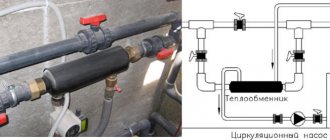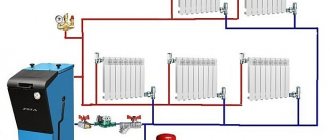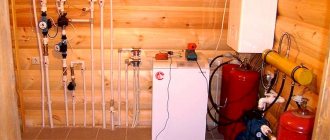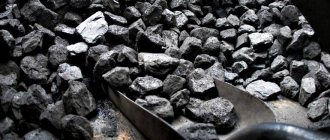The issue of installing an autonomous heating system deserves a thorough, comprehensive consideration, because the costs for it make up a significant part of the budget. To make a balanced determination of the appropriate option, you need to determine in advance what is cheaper - gas or electricity. This often depends on many factors.
On the one hand, there are one-time costs for installing equipment and connecting communications, and on the other, annual payments for gas, electricity, and maintenance of appliances and devices. All this can be calculated independently. The result will help you make an informed choice in favor of one of the methods of heating your home.
You will find detailed answers to really important questions in the article we presented. We will tell you how and by what criteria the economic side of organizing a heating system is determined. Our recommendations will help you decide which option will be more practical.
Main types of heating costs
To correctly estimate the cost of heating a country house, you need to take into account all types of expenses that the homeowner will have to bear.
When using gas or electricity, automatic heating is possible. This gives many advantages to people living in a country house and allows them not to waste their time maintaining the desired microclimate in the premises. However, automation will increase the cost of both systems.
The presence of a gas pipeline near the house does not mean the possibility of connecting to it. To find out the answer, you need to request technical conditions from the gas supply organization. They are given out free of charge
Costs can be categorized as follows:
- Capital investments in installing a heating system based on gas or electricity differ only in the connection of communications, the cost of the boiler and the price for its connection. The water circuit, shut-off and control valves do not depend on the type of energy carrier.
- Annual costs for repairs and maintenance of equipment. This expense item is usually the smallest, but you also need to remember about it.
- Energy costs. They depend on the volume consumed, tariffs adopted in the region, the location of the facility (urban or suburban area) and some other factors.
Thus, costs S (rub.) can be calculated using the following formula:
S = N + (R + E) × T , where:
- N – capital investments;
- R – annual costs for equipment repairs;
- E – annual cost of energy carrier;
- T – number of years in the calculation period.
When comparing several heating options, a situation often arises where high one-time costs for equipment can pay off over time due to the relative cheapness of the energy carrier.
Gas heating
Firstly, your gas must be supplied , which in itself costs money, and quite a lot.
Secondly, for such an area a boiler with a power of only 10 kW will be sufficient, that is, you do not need to buy 20 - 25 kW, there is simply no need. You can still consider 15 kW, however, if the boiler is not operating at 100% load, its resource increases.
Third, gas currently costs about 2.5 - 3 rubles, it all depends on the geography of our homeland. In my city it’s 2.5 rubles, so I’ll count at this rate.
Gas is a very “energy-intensive” product; when burned, a lot of heat is released! Heating boilers now have a very high efficiency (often it is not lower than 80 - 90%) - they take up little space, operate autonomously and require virtually no maintenance. As it becomes clear, the boiler itself cannot heat the room; it needs a heating system, usually cast iron or aluminum batteries that are “tied” to polypropylene pipes - a reasonable solution.
Now that we've decided, let's move on to gas calculations
I have a very clear example of such a house (it’s not very well insulated, there are old places that need to be further insulated), the gas consumption per day (in cold weather) is about 10 - 12 cubic meters, let’s take 12 as a maximum.
If we derive final consumption then 12 X 2.5 r = 30 r. Then for a month it turns out 30 X 30 days = 900 rubles! Tolerate it!
Capital investment and equipment support
The costs of connecting an electric boiler “from scratch” are insignificant compared to gas-fired equipment. It can be installed in any free space, even in a residential area.
Powerful electric boilers operate on 380 V. Therefore, when installing such equipment, you will have to spend money on a three-phase connection at home
Installing gas equipment is much more difficult and expensive, as you will have to complete the following steps:
- Obtain technical specifications from your local gas supply organization. You must indicate the estimated gas consumption.
- Organize a separate place for the boiler with sufficient ventilation. Acceptance of the boiler before starting its operation and an annual safety check will be carried out by a specialist from the gas company.
- Lay gas communications in the premises. To avoid problems with acceptance, it is better to have this done by a gas company specialist.
- Set up a system for removing combustion products.
When choosing a system that runs on liquefied gas, you need to organize the installation of a gas holder, since heating the house with cylinders will be very expensive. In addition, you will often have to refill the cylinders, so the heating process can hardly be called automatic.
For small houses and warm regions where gas consumption for heating is insignificant, you can combine several cylinders using a ramp, but this solution is also less economical than even a small-volume gas holder.
The gas holder can be installed in a pit excavated from any side of the house. The communications connected to it will not be visible and will not interfere with the construction of the lawn. However, it is impossible to place beds and household buildings above the equipment and pipelines - it is necessary to maintain the ability to monitor the condition of the system, maintain and repair
Designing and connecting to the gas main also requires significant funds. The price for this service depends on the region of residence and the topology of the site on which the cottage stands.
On average, the estimate, installation of a gas pipeline from the outlet to the gas consumer and putting the site into operation can cost from 80 to 300 thousand rubles.
Estimation of the required volume of energy carrier
Many cottages were built according to individual projects using building materials, thermal insulation, and finishing that varied in structure and thermal technology. In addition, winter climatic parameters for different regions can vary greatly. Therefore, there may be significant differences in calculations of the volume of energy that will be needed to heat a house.
Calculation of the required amount of heat
Heating is designed to compensate for the heat loss of the building, which occurs for two reasons:
- energy loss due to freezing of the perimeter of the house;
- replacement of warm air with cold air during ventilation.
In order to understand whether it is more profitable to heat a private house - gas or electricity, it is not necessary to carry out highly accurate calculations. An approximate estimate (± 20%) of the volume of heat loss during the winter period is sufficient to determine the difference in the final cost of the energy carrier.
Insulating a country house is a great way to save on heating costs. This will not reduce capital investment, but will reduce annual payments for gas or electricity
There are two options according to which it is possible to determine the amount of heat loss with acceptable accuracy:
- Order a calculation of this parameter from heating engineers. In this case, to save money, it should be mentioned that calculations can be carried out using a simplified method.
- Carry out calculations yourself, knowing such parameters as heat transfer resistance coefficients of house materials, perimeter and roof area, ventilation volume, temperature difference, etc.
The obtained heat loss results must be converted to a standard unit of measurement - W.
Electricity and gas consumption
Instead of calculating heat loss, you can use the analogy method. If nearby (the coincidence of climatic conditions is very important) there is a building similar in geometry and material, then you can find out the volume of gas or electricity consumed by the meter readings.
In this case we have three options:
- the heat loss of the building is known;
- there is data on the volume of gas consumed at a similar facility;
- the amount of electricity spent on heating is known.
It is necessary to find out the volume of electricity and gas consumption during the winter period.
If the boiler also provides hot water, then additional electricity or gas consumption will need to be taken into account in the calculations
First of all, you need to determine the duration of the heating period E (hour). This can be done according to column No. 11, table No. 1 of SNiP 01/23/99. To do this, you need to select the nearest town and multiply the number of days by 24 hours.
Since the calculations allow for minor approximations, we set the following constants:
- The efficiency of the electric boiler is 98%;
- The efficiency of the gas boiler is 92%;
- the calorific value of natural gas is 9.3 kW × h / m3;
- The calorific value of liquefied gas is 12.6 kW × h / kg.
In this case, the basic conversion formulas will have the following form:
- The volume of consumed natural gas V (m3) is known. Heat loss of the building: Q = V × (9300 × 0.92) / E.
- The mass of consumed liquefied gas V (kg) is known. Here, for a propane-butane mixture, you can use the ratio 1 kg = 1.66 liters. Heat loss of the building: Q = V × (12600 × 0.92) / E.
- The amount of consumed electricity V (W × h) is known. Heat loss of the building: Q = V × 0.98 / E.
- The building's heat loss Q is known. The required volume of natural gas is: V = Q × E / (9300 × 0.92).
- The heat loss of the building Q is known. The required volume of liquefied gas: V = Q × E / (12600 × 0.92).
- The building's heat loss Q is known. The required amount of electricity is: V = Q × E / 0.98.
Calculating the heat loss of a building has another purpose - it can be used to calculate the maximum consumption of electricity and gas during the coldest five-day period of the season. This will help you choose the right boiler power and avoid problems with overload.
During extreme cold weather, electricity consumption increases sharply, which can lead to failures. Therefore, you need to have backup power or use thermal accumulators
When comparing the cost of gas and electric heating, the autonomous power supply system does not need to be taken into account, since in extreme frosts it can be used with any type of fuel.
Price
Electric heating cost
Any homeowner will tell you: electricity is the most expensive heat available. A large house is heated with electricity, with tears in their eyes, when there is simply no other choice. They are trying to use favorable night rates and heat with wood or pellets during the day.
Judge for yourself: in December 2021, the cost of kWh in the Moscow region is 5.29 rubles. By the way, tariffs for your region can be easily found on the map here.
At this rate for a house of 100 sq. m will cost approximately 15 thousand rubles per month. 10 kW is consumed per hour at 5.29 rubles, per day (based on 10 working hours of heating) - 529 rubles. In 30 days you will earn 15,870 rubles.
By the way
If you want to reduce heating costs by 3 times, discuss the installation of liquefied gas with an engineer.
Save on heating
If you use heating in a house with an electric stove and only at night, at reduced rates, then the amount will be approximately half as much - 5-7 thousand rubles. And this is payment only for heating, excluding electrical appliances.
In a village (rural settlement, not a dacha community) tariffs are much lower (1.4-1.5 rubles per kW/hour), but there it would not even occur to anyone to “heat” with electricity - the entire pension will “burn out”.
How much does it cost to refill a gas tank?
The first expense, also known as an investment, when choosing autonomous gas heating is the installation of an underground gas tank, from where the fuel will flow into the heating system.
Installing a gas tank on a site costs from 200 to 700 thousand rubles. Then you fill up with fuel once every six months or a year + call specialists to inspect the tank in spring and autumn.
Gas holder heating: cost per month
The cost of periodically refilling a gas tank depends on the volume of heated premises, the insulation of the house and the tariffs of your supplier. If you count monthly, you get quite reasonable money.
Here are calculations for LPG consumption for heating houses of different sizes. Please note that we are calculating at a high winter price: 21 rubles per liter of liquefied gas. In spring, the cost of a liter of LPG is 12-14 rubles.
Calculate yourself
Tariffs 2021. Moscow region
| Multi-tariff metering using a tariff differentiated by day zones | ||||
| night zone T2 (23:00-7:00) | 2,25 | 1,57 | 1,57 | 2,25 |
| half-peak zone T3 (10:00-17:00; 21:00-23:00) | 5,29 | 3,71 | 3,71 | 5,29 |
| peak zone T1 (7:00-10:00; 17:00-21:00) | 6,88 | 4,82 | 4,82 | 6,88 |
| House size, sq. m | LPG Expenses per month, rubles | LPG Cost for 12 months, rubles* | Electricity Expenses per month, rubles. Regular rate. We heat for 10 hours | Electricity Cost for 12 months, rubles*. Regular rate. We heat for 10 hours | Night tariff Expenses per month, rubles. We heat for 8 hours | Night tariff Cost for 12 months, rubles. We heat for 8 hours |
| 100 | 4 075 | 48 900 | 12 696 | 152 352 | 5 400 | 64 800 |
| 150 | 5 512 | 66 150 | 23 805 | 285 660 | 8 100 | 97 200 |
| 300-350 | 11 025 | 132 300 | 47 670 | 571 320 | 16 200 | 194 400 |
| 450 | 14 166 | 170 000 | 71 415 | 856 980 | 24 300 | 291 600 |
*Calculations were provided by Ilya Pechenin, head of the autonomous gasification department at Termo Life.
3
Tariffs and final cost calculation
Knowing the volume of energy consumed and its cost, you can simply multiply to calculate heating costs. This is true for gas, but for electricity there are some nuances.
In rural settlements, as well as city apartments or private houses not connected to gas, there is a reduction in payment for electricity. To confirm the right to use a preferential tariff, you must provide a package of documents to the organization providing electricity supply.
If gas is supplied to the house, but the owner does not want to use it, then this will not be a basis for applying a reduction factor
There is also another way to reduce electricity bills - switch to a tariff differentiated by time of day. To do this, you need to apply to the sales company and purchase a multi-tariff meter.
In order for the boiler to work only at night, you will have to organize a special battery for the coolant. It is a well-insulated container of large capacity. This also requires some investment.
Example of calculating heating costs
Let's take as an example a cottage with an area of about 200 m2 in the vicinity of Barnaul. The average heat loss of a house made of aerated concrete with 50 mm insulation will be about 8000 W, and the maximum will be 18000 W. The duration of the heating period is 235 days or 5640 hours.
Let's calculate the capital costs of installing boilers and providing access to energy resources. When organizing home heating using electricity, the costs will be as follows:
- Connection of additional power up to 30 kW – 15 t.r.
- Three-phase electric boiler Ferroli Zews 28, power 28 kW - 51 tr.
- Heat accumulator S-Tank HFWT series for 750 liters – 54 tr.
- Installation of equipment – 4 tr.
Total: Ne1 = 70 tr, and taking into account the heat accumulator: Ne2 = 124 tr.
A boiler of such power is necessary if the consumer plans to heat the house at night using a differentiated tariff. When compensating for average heat losses of 8 kW, a boiler power of 28 kW is required if the equipment operates 7 hours a day. In severe cold weather, a boiler of this power will have to be turned on during the day.
An electricity supply organization can connect more than 15 kW to a house only if this is technically possible. If the networks are overloaded or worn out, a failure may occur
Let's calculate the capital costs of supplying gas and installing boilers powered by it:
- Technological connection of main gas. The house is classified in the first category, i.e. is located at a distance of less than 200 m from the pipe and does not require the installation of reduction gears. If this is not the case, then the price will be higher. They paid 28 thousand rubles for connection.
- Laying a gas pipeline through the site. Topoplan preparation, project development, its approval and registration, construction, installation and commissioning works. Payment under the contract amounted to 85 thousand rubles.
- For liquefied gas, it is necessary to purchase and install an underground gas tank with a volume of 2.5 m3 and lay a pipeline to the boiler. Turnkey price – 270 tr.
- Gas boiler Viessmann WH1D272, power 24 kW - 90 tr.
- Installation of equipment – 8 tr.
- Putting the entire system into operation with a call from an Altaikraygas inspector - 45 rubles.
In total, capital costs for heating using main gas will be: Ng1 = 256 tr., and liquefied: Ng2 = 413 tr.
Equipment maintenance costs (minor repairs and maintenance) can be taken equal to 10% of its cost. However, for the supply of gas it is necessary to conclude an agreement, and payment for annual inspection services will also be required. Calling a BarnaulGorGaz specialist will cost 3 thousand rubles.
Therefore, for an electric boiler the cost of annual maintenance is: Re = 5.1 t.r., and for gas equipment: Rпг = Rсг = 12 t.r.
According to Decree of the Government of the Russian Federation No. 410 of May 14, 2013, mandatory annual maintenance of in-house gas equipment can be carried out by organizations included in a special register
Let's calculate the amount of energy required for the winter period:
- electricity: Ve = 46 mW × h;
- natural gas: Vpg = 5273 m3;
- liquefied gas: Vсг = 3892 kg.
Energy costs for the entire winter period will be as follows:
- Electricity. With a single-tariff connection in rural areas, 1 kWh costs 3.2 rubles. Eе1 = 46000 × 3.2 = 147.2 tr.
- Electricity. With a two-tariff connection in rural areas, 1 kWh = 2.07 rubles. Ee2 = 46000 × 2.07 = 95.2 t.r.
- Natural gas. Its cost is 6.45 r/m3. Epg = 5273 × 6.45 = 34 t.r.
- Liquefied gas. Its cost will be 36.1 rubles / kg. Esg = 3892 × 36.1 = 140.5 tr.
The price for liquefied gas is given taking into account two refills of a gas tank with a volume of 2.5 m3.
After these calculations, the heating cost equation will take the form:
- for electricity at the general tariff: Se1 = 70 + 152.3 × T;
- for electricity at a two-zone tariff: Se2 = 124 + 100.3 × T;
- for natural gas: Spg = 256 + 46 × T;
- for liquefied gas: Sсг = 413 + 152.5 × T.
From these numbers you can get an idea of how profitable a particular type of fuel is.
The dynamics of heating costs can most easily be traced using a graph of the growth of investments versus time. The equations are simple and linear
For this particular facility, we can conclude that the best heating method is to use mains gas. In just three years it will prove to be the most economical type of heating.
Installing an electric boiler is cheaper and faster, as it requires fewer approvals. But subsequently, paying for electricity will lead to more serious expenses than when using main gas. The two-tariff system will pay for itself in the first year.
Heating based on liquefied gas is absolutely unprofitable economically. It can only be used if there is no technical possibility of connecting to both main gas and electricity with a power of 30 kW or more.
Comparison of gas and electricity costs
What to choose—a gas tank as a source of fuel or electricity—also depends on specific conditions: the type of home, the amount of tariffs, the ability to influence the cost of a particular energy source.
When used in the home
In a private home, the energy source can be main gas, a propane-butane mixture from a gas tank, and electricity:
- when using electricity with a single tariff connection and the price of electricity is 3.2 rubles. the cost of heating will be 147.2 thousand rubles;
- with two tariffs, the amount is reduced to 95 thousand rubles;
- if main gas is used as an energy source, heating costs up to 34 thousand rubles;
- if liquefied gas - 140.5 thousand rubles.
It is most profitable to connect to the gas main. The second most economical method is a two-tariff connection. A single-tariff connection and a gas tank have the same cost.
In the apartment
There is less choice here: mains gas or electricity. According to previous calculations, it is clear that preference should be given to centralized gas supply.
If the apartment owner has the right to benefits when paying for electricity, installing an electric stove may be more profitable, taking into account the fact that the initial cost of gas appliances, their maintenance and installation is more expensive than electric ones.











